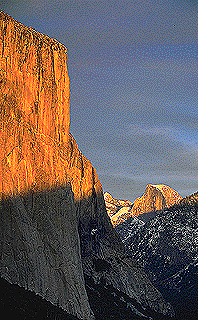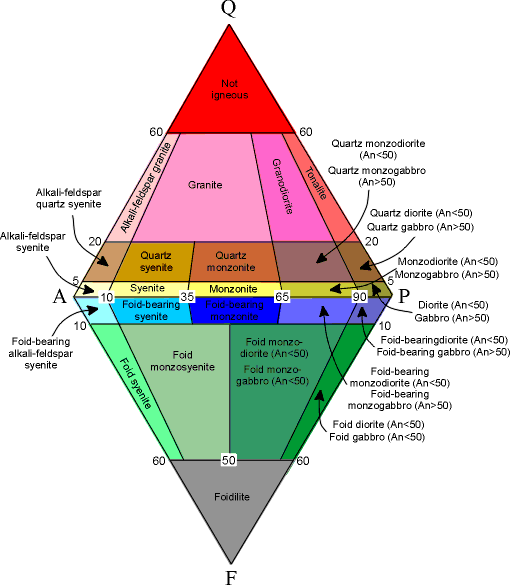
|
Igneous Rock Identification
The eruption of a volcano is an awesome process. Unfortunately, (or fortunately!) most of us will never experience it in our lifetime. But we might have the opportunity to see the products of volcanic processes while driving across country or hiking in the woods. Volcanic rocks, the solidified products of volcanic eruptions are part of a larger group of rocks called igneous rocks.
IGNEOUS ROCKS
Igneous rocks are crystalline or glassy rocks formed by the cooling and solidification of molten magma. Igneous rocks comprise one of the three principal classes of rocks, the others being metamorphic and sedimentary.
Igneous rocks are formed from the solidification of magma, which is a hot (600 deg.C - 1300 deg.C, or 1100 deg. - 2400 deg. F) molten or partially molten rock material. The Earth is composed predominantly of a large mass of igneous rock with a very thin covering of sedimentary rock. Whereas sedimentary rocks are produced by processes operating mainly at the Earth's surface such as weathering and erosion, igneous--and metamorphic--rocks are formed by internal processes that cannot be directly observed.
Magma is thought to be generated within the asthenosphere (the layer of partially molten rock underlying the Earth's crust) at a depth below about 60-100 kilometers (40-60 miles). Because magma is less dense than the surrounding solid rocks, it rises toward the surface. It may settle within the crust or erupt at the surface from a volcano as a lava flow. Rocks formed from the cooling and solidification of magma deep within the crust are distinct from those erupted at the surface mainly owing to the differences in conditions in the two environments. Within the Earth crust the temperatures and pressures are much higher than at its surface; consequently, the hot magma cools slowly and crystallizes completely. The slow cooling promotes the growth of minerals large enough to be identified visually without the aid of a microscope (called phaneritic, from the Greek phaneros, meaning "visible"). On the other hand, magma erupted at the surface is chilled so quickly that the individual minerals have little or no chance to grow. As a result, the rock is either composed of minerals that can be seen only with the aid of a microscope (called aphanitic, from the Greek aphanes, meaning "invisible") or contains no minerals at all (in the latter case, the rock is composed of glass, which is really a viscous, non-crystalline liquid). This results in two groups of igneous rocks: (1) plutonic or intrusive igneous rocks that solidified deep within the earth and (2) volcanic, or extrusive, igneous rocks formed at the Earth's surface.
The deep-seated plutonic rocks can be exposed at the surface for study only after a long period of weathering or by some tectonic forces that push the crust upward or by a combination of the two. The exposed intrusive rocks are found in a variety of sizes, from small dikes to massive dome-shaped batholiths, which cover hundreds of square miles and make up the cores of many mountain ranges.
Extrusive rocks occur in two forms: (1) as lava flows that flood the land surface much like a river and (2) as fragmented pieces of magma of various sizes (pyroclastic materials), which often are blown through the atmosphere and blanket the Earth's surface upon settling. The coarser pyroclastic materials accumulate around the erupting volcano, but the finest pyroclasts can be found as thin layers located hundreds of miles from the opening. Most lava flows do not travel far from the volcano, but some low-viscosity flows that erupted from long fissures have accumulated in thick sequences. Both intrusive and extrusive magmas have played a vital role in the spreading of the ocean basin, in the formation of the oceanic crust, and in the formation of the continental margins. Igneous processes have been active since the formation of the Earth some 4.6 billion years ago.
CLASSIFICATION
Igneous rocks are classified on the basis of mineralogy, and texture. As discussed earlier, texture is used to subdivide igneous rocks into two major groups: (1) the plutonic rocks, with mineral grain sizes that are visible to the naked eye, and (2) the volcanic types, which are usually too fine-grained or glassy for their mineral composition to be observed without the use of a microscope. Being rather coarsely grained, phaneritic rocks readily lend themselves to a classification based on mineralogy since their individual mineral components can be discerned, but the volcanic rocks are more difficult to classify because either their mineral composition is not visible or the rock has not fully crystallized owing to fast cooling.
 A plutonic rock may be classified mineralogically based on the actual proportion of the various minerals of which it is composed. In any classification scheme, boundaries between classes are set arbitrarily; however, if the boundaries can be placed closest to natural divisions or gaps between classes, they will seem less random and subjective, and the standards will facilitate universal understanding. The most commonly used scheme was devised by the International Union of Geological Sciences (IUGS)(See image). A plutonic rock may be classified mineralogically based on the actual proportion of the various minerals of which it is composed. In any classification scheme, boundaries between classes are set arbitrarily; however, if the boundaries can be placed closest to natural divisions or gaps between classes, they will seem less random and subjective, and the standards will facilitate universal understanding. The most commonly used scheme was devised by the International Union of Geological Sciences (IUGS)(See image).
While such a classification is desirable for petrologists, the average earth scientist relies on a much simpler scheme. That classification takes advantage of simple associations that occur among the various silicate minerals. We do not need to know percentages of the various mineral phases, merely which minerals are present. While not as accurate or precise as the IUGS classification it is more than adequate for field and lab studies. We will be utilizing this classification as our basis for identifying igneous rocks.
Volcanic rocks present a greater challenge. Since many of the mineral grains are not visible, using a mineralogical classification becomes problematic. Ideally we would like to have a chemical analysis. However, most lay people have little access to analytic facilities and a classification based on chemistry, although desirable, is rather impractical. Thus, most field classifications of volcanic rocks rely on the few phenocrysts
(large crystals) we can see or the rock's color. The latter can be especially unreliable, but often it is the only clue we have. We shall attempt to rely on texture, color and phenocryts to identify our volcanic rock specimens. To learn more about textures and mineralogy of igneous rocks click on the links below.
Now you are ready to identify some common igneous rocks. 
|

